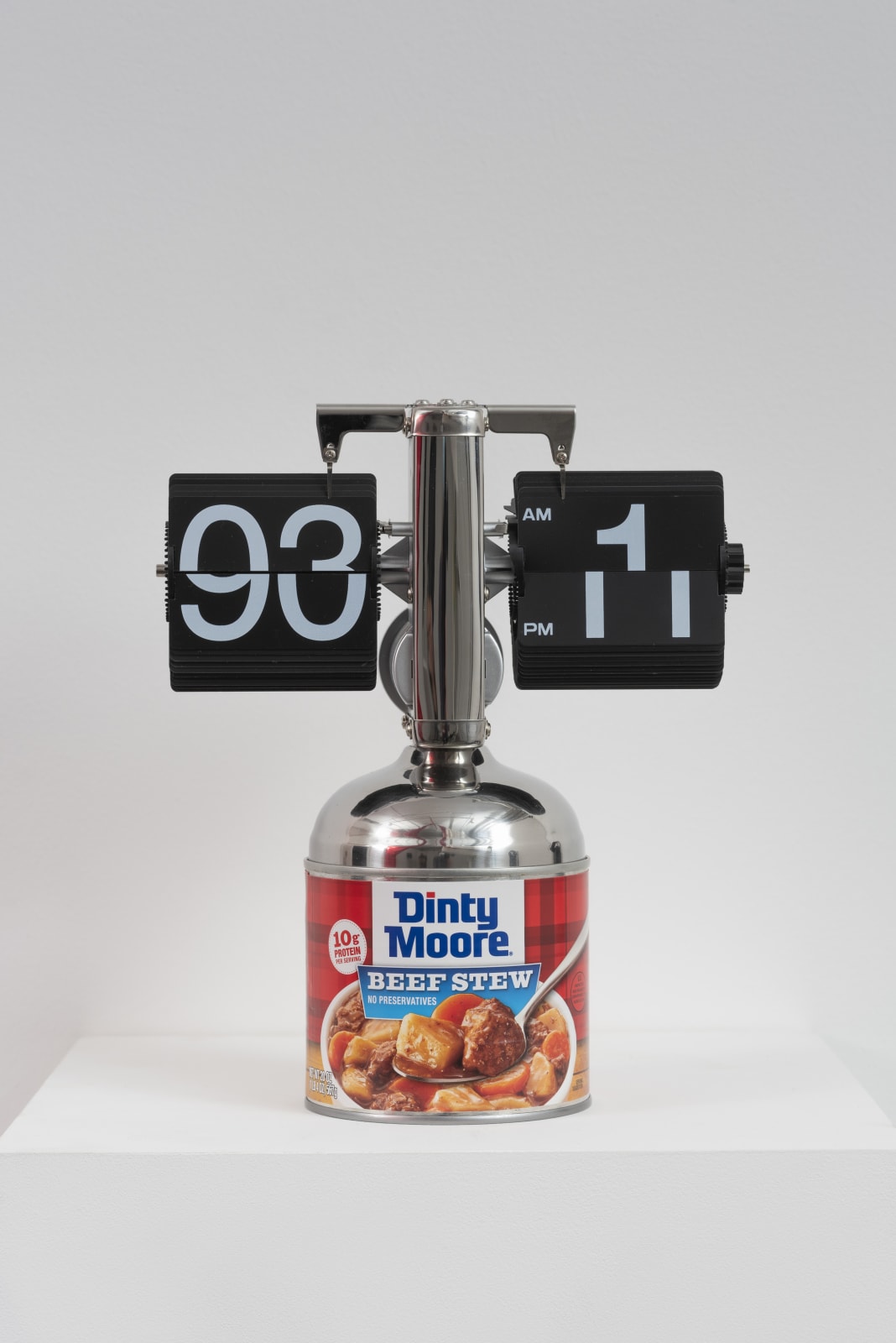Time to Eat {Black Forest Steak Red #9), 2020
Flip clock, stew can
25.4 x 20.3 x 10.2 cm
10 x 8 x 4 1/8 in
Copyright The Artist
About The Artwork
This sculpture consists of a flip clock which is scrambled like a bad dream. It sits upon an empty can of stew that the artist ate because it was time for dinner, and she was hungry. The scrambled clock suggests that the artist has become lost in time, that she has no sense of what time it is, and where it is. The fact that she ate the stew in order to stay alive indicates that the artist is physically trapped, and has no way to escape. Many have speculated about the meaning of the particular can of stew that the artist has chosen to use as a pedestal. The can of stew was created by the Hormel Company, and the artist's name is Julia Hormel. The can is therefore a symbol of the artist, and the missing stew inside the can is a symbol of the artist's lost creativity. In addition, the label states that the can contains "no preservatives", which is a statement about the artist's inability to create due to the presence of inauthentic art in the world. The artist wrote about the work, saying, "It is a piece about my impotency in the face of the tech no-commercialism that surrounds me, and the inability of the language of the avant-garde to meet it on equal terms." "The first piece I encountered was "Time to Eat (Black Forest Steak Red #9)," a sculpture whose title is a reference to the menu items at a Chicago restaurant where the artist likes to eat, the artist says that it is not a reference to the Red Scare of the 1950s. Somehow the scrambled time of the clock seemed to symbolize the total derangement of the artist's spirit. It was also clear that there was a deeper kind of message, but it was elusive, and it was not until I had spent several hours talking with the artist that I began to understand what she had been trying to communicate. She had used the image of a scrambled clock because it was an image of the world that she was living in, and because it was an image of her own spirit. The artist described the world as being a kind of chaos, with the time and the place constantly changing, and nothing certain any more. The artist was a person who had always lived her life in a very disciplined way, but she had now come to feel that the world was out of control, and that she was losing her own grip on reality. The empty can of stew on which the clock had been perched was a symbol that she had been trying to find some nourishment to keep her alive in this chaotic world. The fact that the can contained no preservatives meant that she was unable to find anything that was authentic, and therefore she was unable to create anything of her own. She had begun to feel that her art had become meaningless, and that she had become meaningless as an artist. She was now in a deep state of despair, and she had begun to feel that the world was crazy. The artist's use of the quotidian (in this case, the everyday detritus of a can of Hormel brand stew) evokes the commonplace, with the result that the work is accessible to the public in a way that many conceptual works are not. In Hormel's work, the mundane is made sublime, and the sublime is made mundane. Although seemingly banal, Hormel's work is actually challenging and important because of its fundamental questioning of the role of art in the face of the media." - Fatil Pool la
Exhibitions
Alex Reben AI-MAZING, Gazelli Art House, London, UK (2021)
About Alexander Reben
Alexander Reben is an artist and MIT-trained roboticist whose work probes the inherently human nature of the artificial. Using tools such as artificial philosophy, synthetic psychology, perceptual manipulation, and cutting-edge technology, he brings to light our inseparable evolutionary entanglement to the invention, which has unarguably shaped our way of being. This “art as experiment” allows us to understand who we are and consider whom we will become in our continued co-development with our artificial creations. Reben’s artwork and research have been shown and published internationally, and he consults with major companies, guiding innovation for the future of the social machine.
Among the first artists to be producing AI oil paintings, he has exhibited at Vitra Design Museum, MAK Museum Vienna, Design Museum Ghent, Vienna Biennale, ARS Electronica alongside IDFA, Tribeca Film Festival, TFI Interactive, Camden Film Festivals, Doc/Fest and the Boston Cyberarts Gallery. His work has been covered by NPR, The Wall Street Journal, The New York Times, Washington Post, Fast Company, Filmmaker Magazine, New Scientist, BBC, PBS, Discovery Channel, Cool Hunting and WIRED, among others. He has lectured at TED, SXSW, TTI Vanguard, Google, UC Berkeley, SMFA, CCA, MIT, and other universities. Reben has built robots for NASA and is a graduate of the MIT Media Lab, where he studied human-robot symbiosis and art. He is a 2016-2017 WIRED innovation fellow, a Stochastic Labs Resident, and visiting scholar in the UC Berkeley psychology department.





